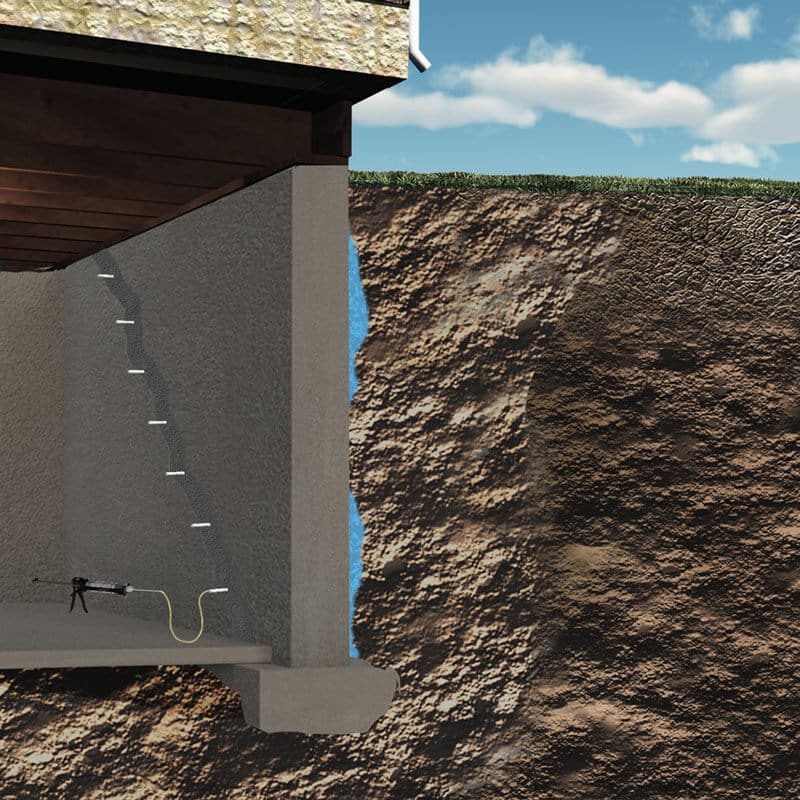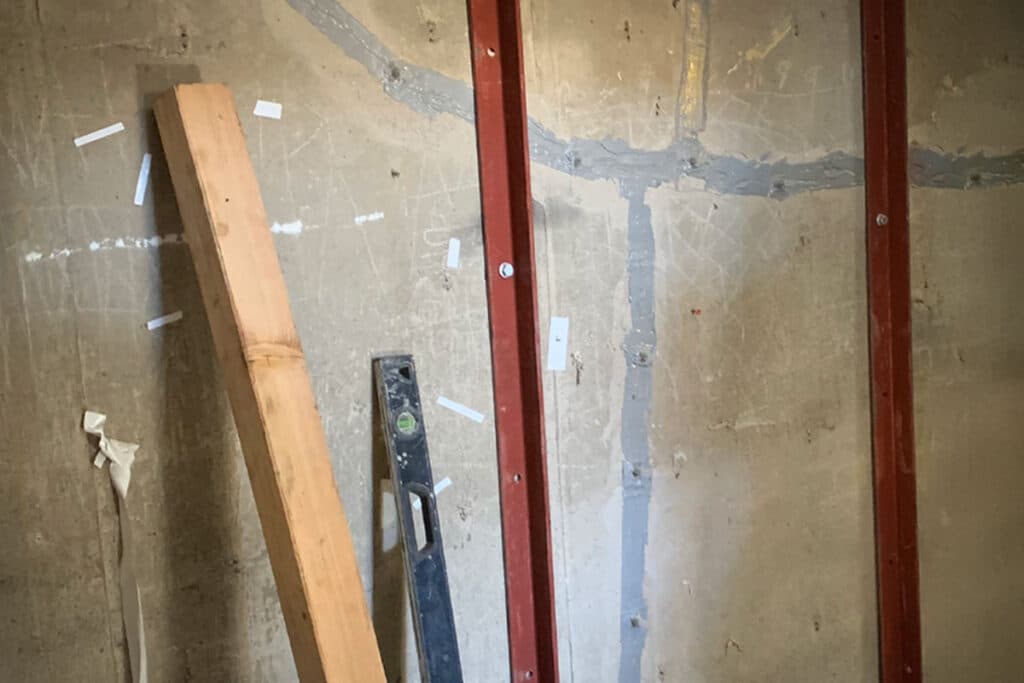Signs You May Need RockSolid™ Crack Injection, Even Without Active Leaks
Not all foundation cracks leak visibly. In fact, some of the most damaging cracks let in moisture slowly, through vapor or capillary seepage, which can go unnoticed for years.
Here’s how to spot the early signs that a crack in your basement wall may need professional sealing:
- You notice discoloration or staining along the crack
Even without water actively dripping, dark streaks, efflorescence (white powdery residue), or rust-colored stains can signal moisture movement through the wall. - The air in your basement feels damp or musty
Moisture entering through unsealed cracks raises humidity, even if you can’t see where it’s coming from. That humidity can lead to mold, odors, and discomfort. - You’ve had mildew or surface mold appear nearby
Wall cracks that let in vapor create the perfect environment for mold to grow behind finished walls or near baseboards. - You see spiderweb or hairline cracks that widen over time
Small cracks can spread with seasonal shifts in moisture or temperature. If you’ve noticed changes over time, even without water, your foundation is moving, and that crack is a risk. - You spot water spots after storms, but not every time
Intermittent leaks are a red flag. The crack may only allow water in during heavy rains or saturated soil conditions, but the damage adds up over time. - You see bugs or pests using cracks as entry points
Thin wall cracks can become access paths for insects, especially if they sense moisture or warmth inside.
Sealing these cracks early, before major leaks or damage occur, can save time, money, and stress later. SouthernDry’s polyurethane injection process permanently seals cracks through the full wall thickness, even if they haven’t begun leaking yet.

Lifetime Warranty
Money-Back Guarantee
Product Replacement for Life
Lifetime TotalCare™ Maintenance
Fair & Honest Pricing
Experience You Can Trust
100% Financing available
Licensed, bonded, and insured
No Sales Games
Industry-leading warranties and guarantees
Recommended by Your Neighbors
A+ BBB Rating
Lifetime Warranty
Money-Back Guarantee
Product Replacement for Life
Lifetime TotalCare™ Maintenance
Fair & Honest Pricing
Experience You Can Trust
100% Financing available
Licensed, bonded, and insured
No Sales Games
Industry-leading warranties and guarantees
Recommended by Your Neighbors
A+ BBB Rating
How Foundation Wall Cracks Form
Concrete naturally shrinks as it cures. Combine that with your home settling into the soil over time, and small foundation wall cracks are common, especially in poured concrete walls. Add in thermal cycles (like freeze/thaw or wet/dry soil shifts), and those hairline cracks can slowly widen.
When moisture starts to work its way into these cracks, the problem escalates. Water seepage erodes the surrounding material, widens the gap, and leads to active leaks. Over time, what started as a thin surface crack can become a long-term source of water damage, mold, and air quality issues.
While most vertical wall cracks are not structural, they should still be repaired to protect your basement from water infiltration and future problems.
What Happens If You Don’t Seal a Wall Crack
Leaking wall cracks only get worse with time. Here’s what can happen if you leave them untreated:
- Water intrusion and standing puddles
Small trickles often turn into full leaks during storms or rainy seasons, damaging storage, flooring, or finished walls. - Mold and mildew growth
Moisture that enters through the wall raises humidity levels and creates ideal conditions for mold growth behind walls or under flooring. - Radon gas and soil vapor entry
Unsealed cracks allow gases from the soil, including radon in certain regions, to seep into your living space. - Widening cracks and additional leaks
Seasonal shifts in soil moisture or temperature can cause cracks to widen. Once water comes in, damage accelerates. - Failed home inspections or lower property value
Evidence of active leaks or moisture damage can complicate real estate transactions and reduce your home’s marketability.


How Polyurethane Crack Injection Works
SouthernDry uses a flexible polyurethane resin that starts as a thin liquid, thinner than water, so it penetrates deep into the crack and fills any connected voids, capillaries, or hidden fractures. Once inside, the resin reacts with moisture and expands, forming a watertight, flexible seal through the full thickness of the wall.
Here’s how we do it:
- Prep the crack: We clean the surface, remove loose debris, and open the edges slightly to allow proper adhesion.
- Drill injection ports: Small holes are drilled about every 10 inches along the length of the crack, and ports are installed for resin delivery.
- Seal the surface: A temporary surface seal keeps the resin inside during injection.
- Inject from bottom to top: Polyurethane is injected under pressure, filling the crack and expanding to form a flexible barrier.
- Finish and clean up: Once cured, the ports and seal are removed, and the surface is cleaned for a smooth finish.
This process is done entirely from the inside and typically takes just a few hours to complete. It can be performed year-round, regardless of weather conditions.
Why Polyurethane Injection Is the Best Option for Wall Leak Repair
- Stops active water leaks fast
Seals the entire depth of the wall, even if water is present during injection. - No exterior digging or landscaping disruption
Repairs are completed from inside your basement, no heavy equipment or backfilled soil to deal with. - Flexible and durable
Unlike rigid epoxies, polyurethane expands and flexes with seasonal foundation movement. - Ideal for poured concrete foundations
Provides long-term protection against leaks without affecting structural stability. - Cost-effective and low-disruption
Fast, affordable, and ready for finished spaces without mess or demolition.
Additional RockSolid™ Crack Injection Applications
While vertical wall cracks are the most common use for polyurethane injection, we also repair other basement leak points using the same proven method:
Tie Rod Injections
Tie rods from original foundation forms can rust and leak over time. We inject around them to stop water from entering.
Cold Joint Injections
Where two pours of concrete meet, such as additions or between walls and footings, cracks often form. Injection seals those joints internally.
Pipe Penetration Injections
Gaps around sewer or water lines where they pass through foundation walls can leak. Injection fills the void and allows for minor pipe movement.
Bulkhead Leaks
Bulkhead stairs may settle, pulling away from the foundation and allowing water in. Injection can help reduce leak paths and support other waterproofing methods.

Protect Your Basement with Professional Crack Repairs
A single wall crack may seem minor, but once it starts leaking, it’s only a matter of time before damage spreads. SouthernDry’s polyurethane crack injection system seals the problem from the inside, without the mess of exterior excavation.
Schedule your free inspection today, and let our experts recommend the best solution to stop leaks and protect your home for the long haul. Find out why SouthernDry is the foundation repair company trusted by countless homeowners in Alabama.



